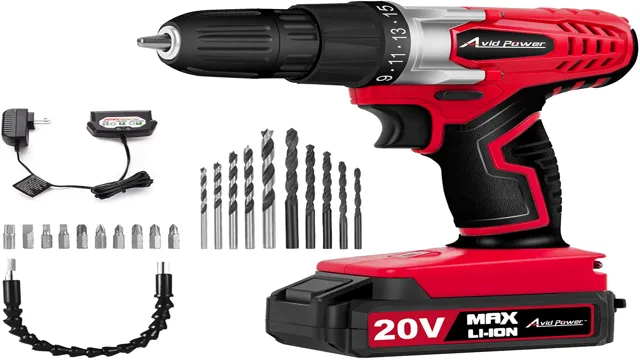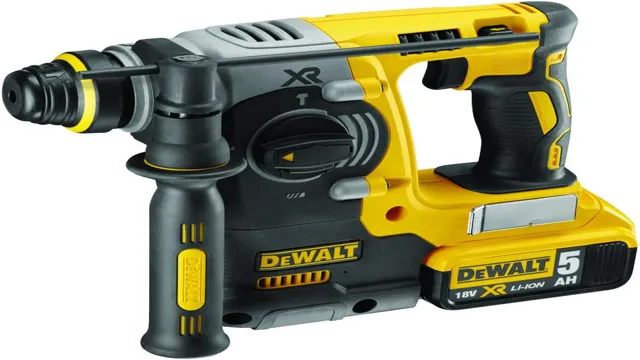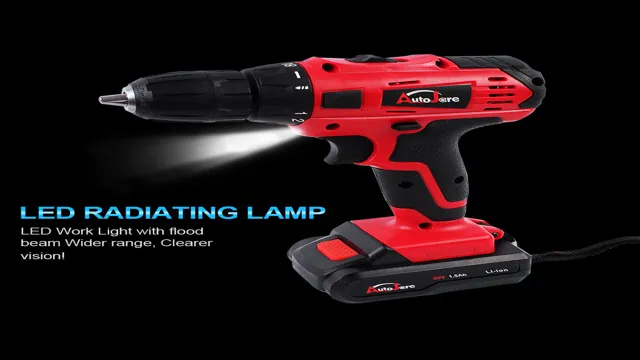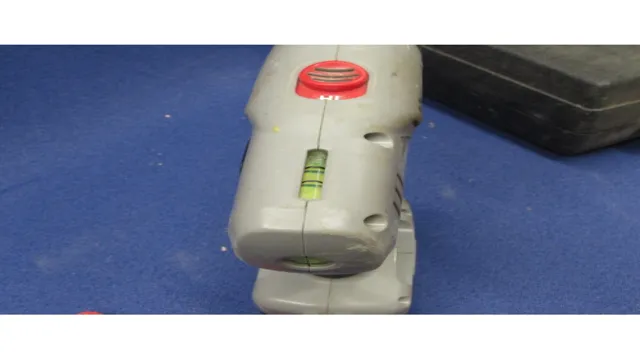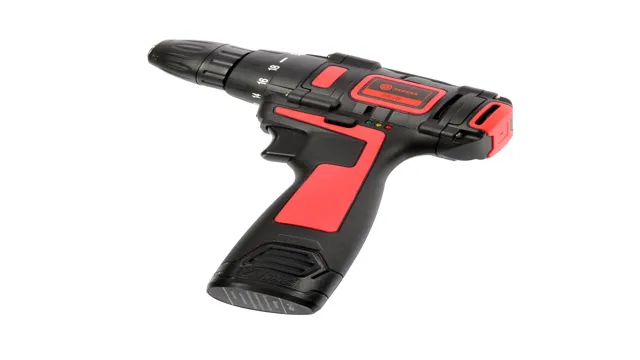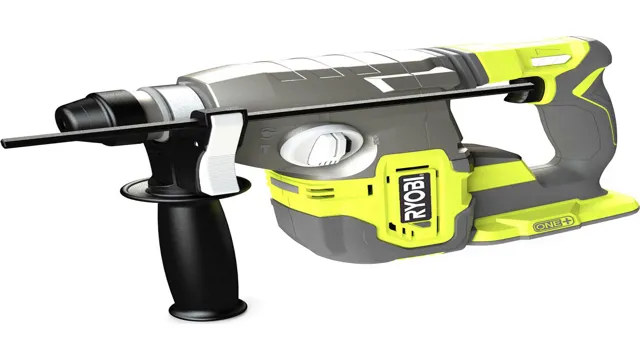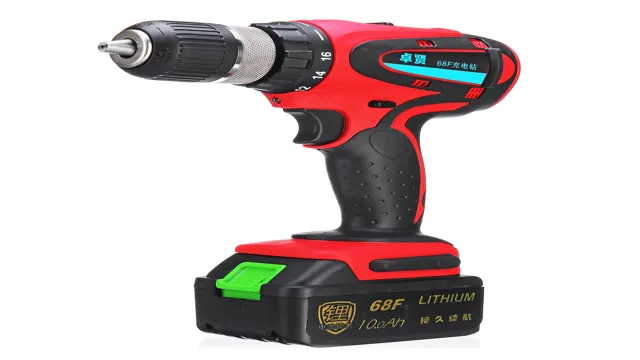Can Cordless Impact Driver Really Drill Concrete? All You Need to Know.

If you’ve ever tried to drill into concrete, you know just how tough it can be. It’s a material that requires some serious power to penetrate, which can leave you frustrated and exhausted. But what if you could accomplish the task with ease using just one tool? Enter the cordless impact driver.
This powerful tool is designed to handle even the toughest materials, including concrete. With its high torque and impact function, it can create holes in concrete quickly and efficiently. Gone are the days of struggling with a heavy drill and bit that barely scrapes the surface.
The cordless impact driver is a game-changer for anyone who needs to work with concrete regularly.
What is a Cordless Impact Driver?
A cordless impact driver is a power tool designed to drive screws and bolts faster and with greater force than a traditional drill. It uses concussive force to drive the fastener into the material, and it’s commonly used in construction, woodworking, and automotive repair. But can a cordless impact driver drill concrete? The answer is yes, but it depends on the type of drill bit.
To effectively drill concrete, you need a masonry bit made of tungsten carbide. It’s important to note that while a cordless impact driver can handle drilling small holes in concrete, it’s not designed for heavy-duty concrete drilling applications. In those instances, a rotary hammer or a hammer drill would be a better choice.
So, if you need to drill a few small holes in concrete, a cordless impact driver can do the job.
Explanation of impact driver and its features
A cordless impact driver is a powerful tool used for driving screws and bolts. It’s a handy device that uses a combination of rotational force and percussive blows to deliver powerful output torque, making it easy to drive screws into dense materials like hardwood, metal, or concrete. The primary feature of a cordless impact driver is its ability to provide a high level of torque, making it one of the most useful tools in the toolbox.
Its compact size and lightweight design make it ideal for use in tight spaces where other, larger tools cannot fit. The impact driver’s battery-powered operation also makes it a convenient tool for use in places where power outlets are scarce. So, whether you’re a DIY enthusiast or a professional contractor, a cordless impact driver should be a must-have tool in your collection.
With its unique combination of power, efficiency, and portability, the impact driver is the perfect tool for any job that requires a high level of torque.

Maximizing Cordless Impact Driver on Concrete
“Can a cordless impact driver really drill into concrete? The answer is yes! With proper technique and the right tools, you’ll be surprised at just how much power these handy little devices can pack. When drilling into concrete, it’s important to use a drill bit that is specifically designed for concrete, as ordinary bits will quickly become dull and ineffective. Additionally, it’s essential to use the correct size and type of battery to maximize the power of your cordless impact driver.
A high-capacity battery will provide more torque, which is critical when working with tough materials like concrete. Finally, don’t forget to take safety precautions. Always wear safety glasses, work gloves, and a dust mask, and be sure to secure your workpiece to prevent it from moving around while you work.
With these tips in mind, you’ll be able to confidently use your cordless impact driver to drill into concrete and tackle any DIY project!”
Benefits of using a cordless impact driver on concrete
If you’re looking to get the job done efficiently and quickly on concrete surfaces, a cordless impact driver is the perfect tool for you. The benefits of using a cordless impact driver on concrete are numerous and invaluable. With the right bit, a cordless impact driver can provide superior torque to allow for easier, quicker, and more precise drilling or driving into concrete.
Unlike a hammer drill, an impact driver is less prone to slipping and is capable of withstanding the commonly observed torque reaction. Its compact and lightweight design also makes it easy to maneuver and transport around the job site. Additionally, using a cordless impact driver can save you time and energy, enabling you to complete your project in a shorter amount of time than other power tools.
With its speed and power, a cordless impact driver is the perfect tool for all your concrete drilling and driving needs.
You May Also Love:
Tips on using cordless impact driver for concrete projects
If you’re planning on using a cordless impact driver for concrete projects, there are a few tips to keep in mind to get the most out of your tool. First and foremost, make sure to use the appropriate bit size and type for the job at hand. Using the wrong bit can damage your driver or lead to inadequate results.
Additionally, make sure to set your driver to the appropriate torque setting to prevent overdriving or stripping the screws. When working with tough concrete, it’s also important to use a high-quality battery with a long life to prevent running out of power mid-job. Finally, always wear eye and ear protection and make sure to use caution when handling your driver.
Remember, a cordless impact driver can be a powerful tool for concrete projects, but it’s important to use it safely and properly to get the most out of your investment.
Cordless Impact Driver vs. Traditional Hammer Drill
Many people wonder if a cordless impact driver can effectively drill through concrete, compared to a traditional hammer drill. While it is true that an impact driver can generate high levels of torque, which is useful for tasks like driving screws and bolts, it may not be the best tool for drilling through tough materials like concrete. In fact, most cordless impact drivers do not have the power needed to drill through solid concrete.
On the other hand, a hammer drill is specifically designed for drilling into hard surfaces and can easily power through concrete. So, while an impact driver may be a versatile and useful tool, it may not be the best option for drilling through concrete. In the end, it all depends on the specific task you need to accomplish and the materials you’re working with.
Comparison of impact driver and hammer drill on concrete
When it comes to working with concrete, two tools you’re likely to encounter are the cordless impact driver and the traditional hammer drill. While both can be effective in their own right, there are some key differences between the two that you should be aware of. On the one hand, cordless impact drivers are known for their power and torque, making them a great choice for tasks that require a lot of force.
They use a hexagonal socket that can be locked into place to hold screwdriver bits, which makes them ideal for driving screws into concrete. They’re also lightweight and easy to maneuver, which means you can work for longer periods without getting tired. On the other hand, traditional hammer drills are designed to produce a high level of percussion, which makes them ideal for drilling into hard materials like concrete.
They use a piston mechanism that delivers a rapid series of blows to the bit, helping it to break through tough surfaces more easily. However, they tend to be heavier and more difficult to handle than impact drivers, which means they may not be the best choice for larger or more complex projects. Overall, the choice between a cordless impact driver and a traditional hammer drill will depend on the specific task you’re trying to complete.
Both have their own strengths and weaknesses, so it’s important to choose the tool that’s best suited to the job at hand. Whether you’re driving screws or drilling holes, the right tool can make all the difference in getting the job done quickly and efficiently.
Cordless Impact Driver Brands for Concrete
If you’re wondering if a cordless impact driver can drill into concrete, the answer is yes, but not all models and brands are created equal. Some of the best options for drilling into concrete include Milwaukee, DeWalt, and Makita. These brands have high-quality impact drivers with powerful motors and durable, long-lasting batteries.
It’s important to note that using an impact driver for concrete should be done with caution and the right technique, as it can be a tough material to drill through. But with the right tool and approach, it’s possible to get the job done efficiently and effectively. So if you need to drill into concrete, consider investing in a high-quality cordless impact driver from a reputable brand.
Top cordless impact driver brands for concrete projects
Concrete projects require a powerful, efficient cordless impact driver, and choosing the right brand can make all the difference. One of the top brands for these types of projects is Milwaukee, with their M18 Fuel lineup featuring impressive power and torque. Another excellent option is DeWalt, particularly their FlexVolt lineup that offers long-lasting battery life and versatile power.
For those on a budget, Ryobi offers affordable options that still deliver strong performance. Finally, Makita is a reliable choice with a wide range of options for both professional and DIY projects. No matter which brand you choose, investing in a high-quality cordless impact driver is essential for successful concrete projects.
Features and specifications of each brand
When it comes to cordless impact drivers for concrete, there are several brands to choose from, each with its own unique features and specifications. One such brand is DEWALT, which offers a high-performance impact driver with a brushless motor and three-speed settings. This driver also has a compact design, making it easier to use in tight spaces.
Another brand is Milwaukee, which has a brushless motor and four-mode DRIVE CONTROL, allowing for better control over the tool. Makita is another popular brand, with an impact driver featuring an efficient brushless motor and an assist mode to help when starting fastening work. These are just a few examples of the many brands available for cordless impact drivers for concrete, each offering its own specific advantages.
Conclusion
In conclusion, while it may seem counterintuitive, a cordless impact driver can indeed drill into concrete with ease. With the right bits and a powerful battery, this tool is more than capable of tackling even the toughest of materials. So, next time you’re working on a project that requires drilling into concrete, don’t be afraid to give your trusty cordless impact driver a try.
You might just be surprised at what it can do!”
FAQs
Can a cordless impact driver drill into concrete?
Yes, a cordless impact driver can drill into concrete with the right masonry bit.
What type of masonry bit should I use with my cordless impact driver to drill into concrete?
You should use a carbide-tipped masonry bit with your cordless impact driver to drill into concrete.
What is the maximum diameter hole that a cordless impact driver can drill into concrete?
The maximum diameter hole that a cordless impact driver can drill into concrete varies depending on the model, but typically ranges from 1/4″ to 1/2″.
How long does a cordless impact driver battery last when drilling into concrete?
The battery life of a cordless impact driver when drilling into concrete depends on several factors, but typically lasts between 30 and 60 minutes.
Can a cordless impact driver be used to remove concrete screws?
Yes, a cordless impact driver can be used to remove concrete screws with the use of a compatible screwdriver bit.
What safety precautions should be taken when using a cordless impact driver to drill into concrete?
Safety goggles, dust masks, and ear protection should be worn when using a cordless impact driver to drill into concrete. It is also recommended to secure the workpiece and firmly grip the tool to avoid injury.
What other materials can a cordless impact driver drill into besides concrete?
A cordless impact driver can drill into a variety of materials, including wood, metal, plastic, and drywall.

